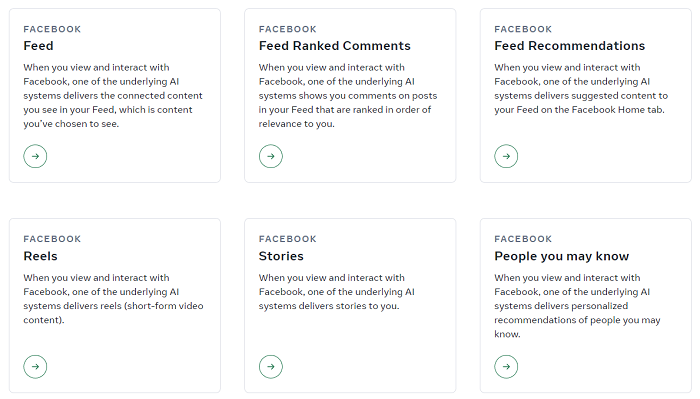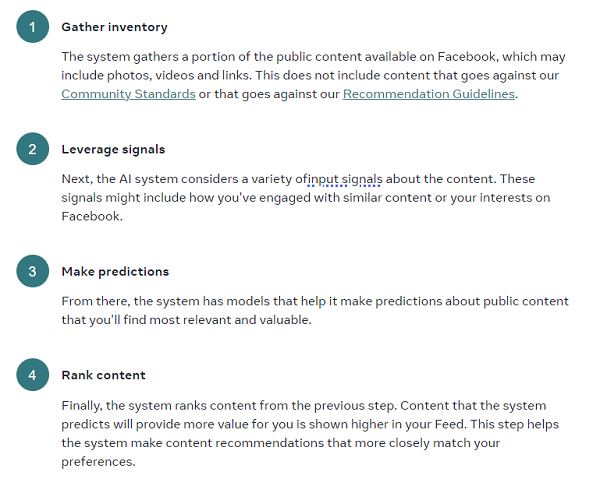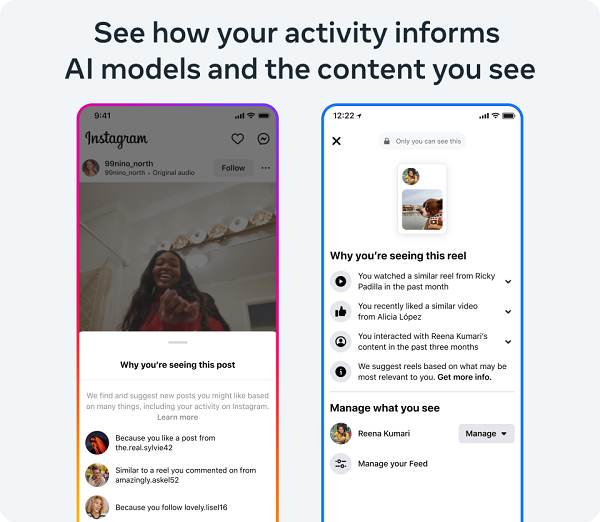Meta has provided a new overview of how its various feed algorithms work, and how it’s utilizing advanced AI systems to help match the right content to interested users in-stream, which could help you better understand why you’re seeing what you’re seeing on Facebook and Instagram.
And for marketers, it could give you a better handle on the same, in order to help you better connect with your target audience.
In a new explainer, Meta’s President of Global Affairs Nick Clegg has highlighted the importance of transparency in utilizing AI in Meta’s recommendation systems, and how people can influence their feed, based on their activity.
As explained by Clegg:
“Our AI systems predict how valuable a piece of content might be to you, so we can show it to you sooner. For example, sharing a post is often an indicator that you found that post to be interesting, so predicting that you will share a post is one factor our systems take into account. As you might imagine, no single prediction is a perfect gauge of whether a post is valuable to you. So we use a wide variety of predictions in combination to get as close as possible to the right content, including some based on behavior and some based on user feedback received through surveys.”
Meta has provided similar overviews of its algorithms before, which seek to explain why people see what they see in their feed.

The core considerations that the system factors in, based on these notes, are:
- Where the post comes from – How often a user engages with a profile or person
- When it was posted – The time it was posted, and initial post response
- How likely that it’ll drive engagement – The system will optimize to best lean into each users’ specific behaviors, including likelihood to comment or share
The incorporation of AI is now helping Meta to double down on these core elements, which will ideally optimize the user experience for each individual, in real-time.
To provide more insight into exactly how the various elements of its systems feed into this, Meta’s released a new set of 22 ‘system cards’ which explain how its systems rank content.

Each card provides a general overview of how Meta’s feed algorithms work, which could help to improve your understanding of what’s impacting both what you see in its apps, and how your content reach is determined.

It’s a handy resource for building your knowledge of the system, which could be a valuable way to maximize content performance – though a lot of the explainers are fairly generic and deliberately vague, as to avoid people using the advice to game the system.
Meta’s also outlined how it’s using AI specifically within its ranking process, with a new overview that explores its improved systematic content understanding, which can now interpret ‘semantic meanings of content holistically across different modalities (such as image, text, audio, or videos)’’.
“These production models provide capabilities such as visual recognition, object detection, text extraction, and audio recognition. They also enable us to do more application-specific tasks, such as topic/genre classification, hashtag prediction, similarity matching, and clustering.”
In other words, Meta’s systems are getting better at understanding what’s presented in every element of your posts, including objects in images and videos, in order to better show the right content to users based on their interests.
TikTok also incorporates similar symbols – which is why you’re likely to be shown more content based on visual cues, as opposed to hashtags or keywords in the description alone. That makes TikTok’s feed even more compelling, and Meta’s now also trying to incorporate the same into Reels, which has been the key driver of Facebook and Instagram engagement growth over the past year.
But there are no secrets revealed here, as such. Meta’s not publishing a talisman that will explain how to boost your reach across its apps, but it is trying to provide a better overview of its ranking system, in order to help users understand the many considerations that factor into what they’re seeing, and how they can influence such, both through their activity and manual controls.
On the latter, Meta’s also looking to provide more insight, with an update to its ‘Why Am I Seeing This?’ element in Reels (both on Facebook and IG) which will provide more information about how your previous activity has informed the Reels that you see.

Meta’s also rolling out new content control options on Facebook and Instagram, where you’ll be able to have more influence over the content that you see in each app.
“You can visit your Feed Preferences on Facebook and the Suggested Content Control Center on Instagram through the three-dot menu on relevant posts, as well as through Settings.”
It’s also adding new ‘interested’ indicators on Reels, so you can tell the system that you want to see more of this type – kind of like Likes, but more direct.
Again, there’s no magic formula here, Meta’s not opening up its black box and letting you into all of its algorithmic secrets. But the new transparency tools do provide more insight into its various ranking models, and the general factors it considers when weighing how to shape each users’ experience.
The real value, from a marketing perspective, would be knowing which elements Meta’s weighting more at any given time, but for one, it’s always changing, and two, giving people a map of how to game the system is probably not the most beneficial exercise.
But if you want to know how Meta’s systems work, and how they’re improving, it could be worth taking some time over the long weekend to go through these explainers and notes.
You can read more about Meta’s algorithmic processes here.



